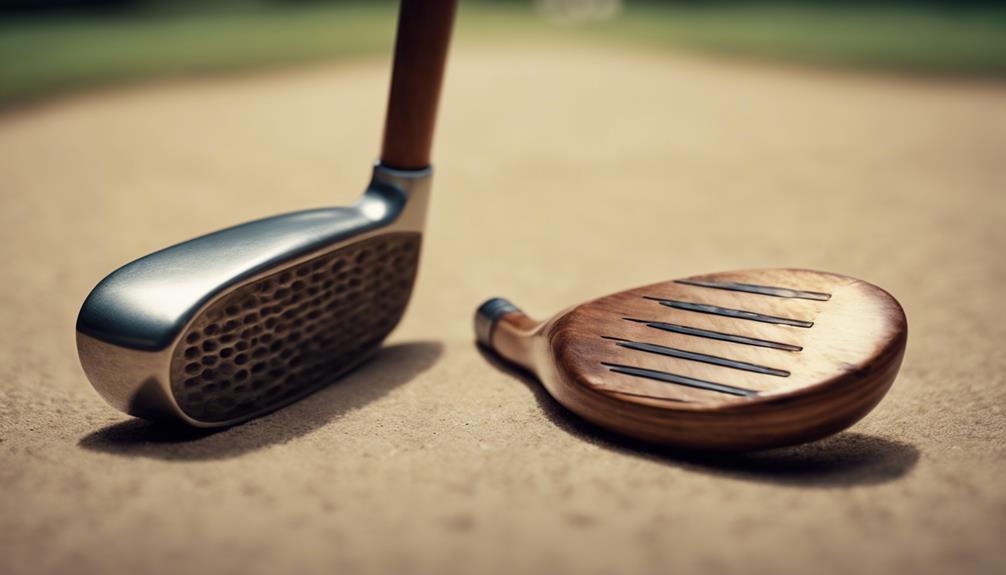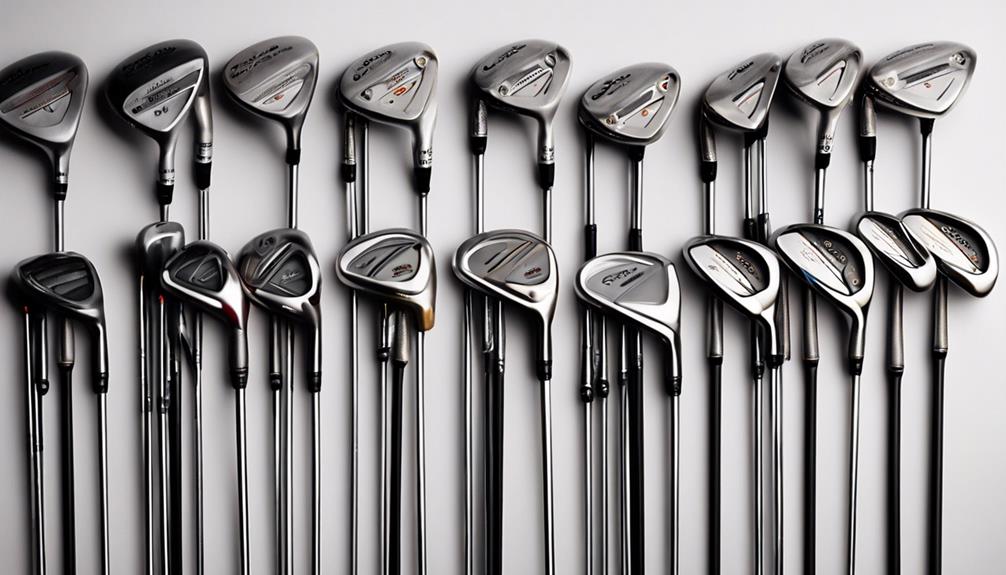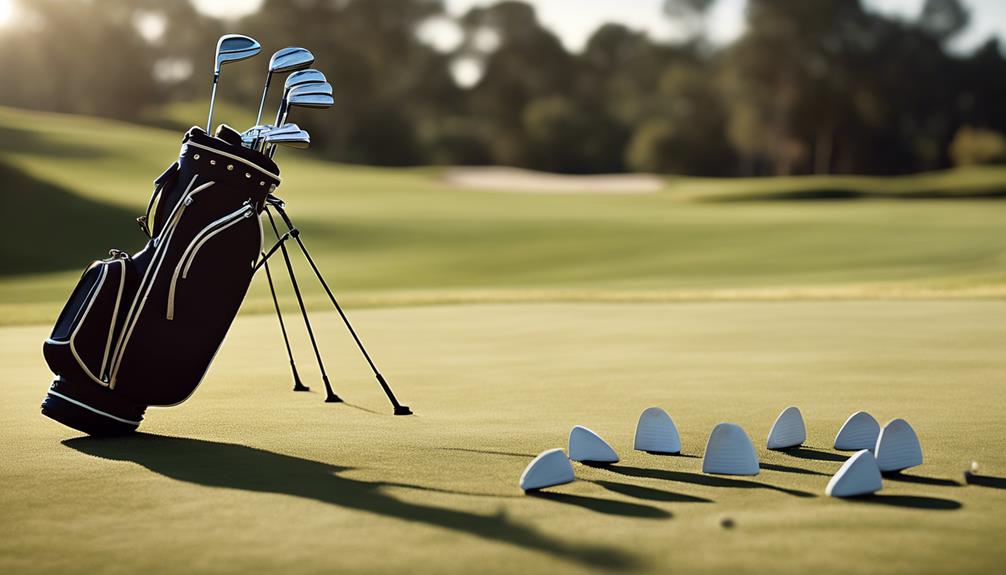- 7 Top Flite Golf Clubs XL for Improved Performance - September 28, 2024
- Top Flite Golf Clubs: Top 5 Reasons to Choose Them - September 28, 2024
- Top 3 Golf Club Fitters for a Perfect Swing - September 28, 2024
You're equipped with a standard set of 14 golf clubs, each designed to tackle specific shots and scenarios on the course. Woods are for long-distance shots, irons for precise shots under 200 yards, hybrids combine features of both, and wedges are specialized for short-range shots. Putters are uniquely designed for use on the green, focusing on accuracy and control. Each club type has its strengths, and understanding their characteristics, including loft angles and design, can enhance your shot selection and overall performance. As you explore the world of golf clubs, you'll discover how mastering each club can take your game to the next level.
Key Takeaways
- There are five main types of golf clubs: woods, irons, hybrids, wedges, and putters, each serving a unique purpose in the game.
- Woods are designed for long-distance shots, irons for precise shots under 200 yards, and hybrids combine features of both.
- Wedges have high loft angles for short-range shots, including pitching, sand, gap, and lob wedges, and are critical for chipping and bunker play.
- Putters are exclusively used on the green, focusing on accuracy and control, and come in various styles to suit different putting techniques.
Types of Golf Clubs Explained
When it comes to selecting the right tool for the job, understanding the five main categories of golf clubs is essential, as each type is designed to excel in specific situations and shot requirements. You'll need to familiarize yourself with woods, irons, hybrids, wedges, and putters to master the game.
Woods, with their larger clubheads, are ideal for long-distance shots from the tee.
Irons, on the other hand, are designed for more precise shots under 200 yards, with a numbered system indicating loft and distance capabilities.
Hybrids offer a versatile option, combining features of woods and irons, making them perfect for replacing long irons.
Wedge clubs, with their high loft angles, are specialized for short-range shots requiring precision and control.
Finally, putters are uniquely designed for use on the greens, focusing on accuracy and control.
Understanding the different types of golf clubs will help you navigate the course with confidence. With this knowledge, you'll be able to choose the right club for every shot, elevating your game and improving your overall performance.
Understanding Golf Club Numbers
As you learn about golf club numbers, you'll discover that they directly relate to the loft angle of the clubface, which in turn affects the distance and height of your shots.
You'll need to understand how the club face angle impacts the ball's trajectory, so you can choose the right club for each situation.
Golf Club Loft
You need to understand the loft angle indicated by golf club numbers, which directly impact the trajectory and distance of your shots. The loft angle is an important factor in club selection, as it determines how high and how far the ball will travel.
In general, lower-numbered golf clubs (e.g., 3-iron) have less loft, resulting in longer, lower shots, while higher-numbered clubs (e.g., 9-iron) have more loft, resulting in higher, shorter shots.
As you move through a standard set of irons (3-iron to 9-iron), each increasing number represents a higher loft and shorter shaft length. Wedges, a subset of irons, have the highest loft angles, designed for precision and control in short game situations. Common wedge lofts include 48, 52, 56, 60, and 64 degrees.
Understanding the loft angle is vital for making informed club selections. It's important to take into account the trajectory and distance you need to achieve in a given situation, considering the loft angle of your golf clubs.
Club Face Angle
Since the loft angle of your golf clubs is directly tied to the club face angle, understanding how these two elements interact is essential for making informed club selections.
The club face angle plays a critical role in determining the loft of the golf club, which in turn affects the trajectory and distance the ball will travel when struck.
As you move through your bag, you'll notice that lower numbered clubs, such as a 3-iron, typically have less loft, resulting in longer, lower shots, while higher numbered clubs, like a 9-iron, have more loft for shorter, higher shots.
Understanding the relationship between club numbers and loft angles helps you select the appropriate club for various situations on the course, ensuring better shot outcomes.
Additionally, the loft angle influences the spin and control of the ball, with higher lofted clubs producing more backspin, which can improve accuracy on approach shots.
Distance and Height
Golf club numbers serve as a fundamental indicator of a club's distance and height capabilities, with each number corresponding to a specific loft angle that determines the ball's trajectory and travel distance.
When you're deciding which club to use, understanding the relationship between club numbers and loft is essential. Lower numbered irons, such as 3-iron, have less loft, resulting in longer distances at a lower height. On the other hand, higher numbered clubs, like 9-iron, have a higher loft, leading to a higher trajectory but shorter distances.
As you prepare to buy golf clubs, it's important to evaluate the different types and their corresponding loft angles. For instance, number irons have varying loft angles, which affect the ball's trajectory and distance.
The loft angle considerably influences the ball's travel distance and height, making it crucial to choose the right club for your shot. By understanding the correlation between club numbers and loft, you'll be better equipped to make informed decisions about which club to use, depending on the distance and height required for your shot.
This knowledge will help you master your game and improve your overall performance.
Characteristics of Wood and Iron Clubs

Characterized by distinct designs and purposes, wood and iron clubs serve unique functions in a golfer's arsenal, with woods excelling at long-distance shots and irons providing precision for shorter-range approach shots.
When you're teeing off or hitting long fairway shots, wood clubs are your go-to choice, capable of propelling the golf ball over 175 yards. Their larger, circular clubheads and longer shafts allow for faster swings, generating more power and distance.
In contrast, iron clubs feature smaller, angled clubheads, ideal for shots within 200 yards of the green. Their design provides better control and precision, making them perfect for approach shots that require accuracy rather than raw power.
While woods are designed for distance capabilities, irons are tailored for shot accuracy, with their thinner profile and focus on precision.
Understanding the characteristics of wood and iron clubs will help you choose the right tool for the job, allowing you to master your game and take your skills to the next level.
Applying Golf Club Knowledge in Play
By grasping the unique strengths of each club type, you can confidently select the perfect tool for the job, leading to more accurate shots and improved overall performance on the course.
When faced with a challenging approach, you can rely on your understanding of loft angles to choose the right club. For instance, opting for a pitching wedge or sand wedge will provide higher lofts and more control, allowing you to precision-approach the green.
Conversely, long irons are designed for longer shots, but require more skill and precision. Clubs are designed to control trajectory, and knowing when to use each type will elevate your game.
By familiarizing yourself with the characteristics of different golf clubs, you'll make informed decisions during play. This knowledge will help you navigate tricky situations, such as deciding between a hybrid and a long iron for a long approach.
As you practice with different clubs in various situations, you'll develop a deeper understanding of the game, ultimately leading to better performance and a more enjoyable round of golf.
Golf Club Basics and Manufacturers

As you explore the nuances of each club type, understanding the fundamental components and design principles behind them becomes essential. This is where manufacturers like Pinemeadow Golf Products, Inc. come into play, offering a range of options tailored to individual golfers' needs.
Golf clubs consist of three main components: the head, shaft, and grip, each playing a vital role in performance and feel. Modern golf sets typically include a combination of woods, hybrids, irons, wedges, and putters to cover various shot types and distances.
Manufacturers adhere to specific rules of golf when designing clubs, while also leveraging technology to enhance performance and maximize physics. With decades of experience, Pinemeadow Golf Products, Inc. has built millions of clubs tailored to the needs of individual golfers.
As you build your golfer's bag, you'll require different club designs based on your skill level. Beginners need more forgiving clubs, while experienced players opt for less forgiving options to improve swing accuracy.
Golf Club Types and Characteristics
When building your golf set, you'll need to understand the distinct features and purposes of each club type, including woods, hybrids, irons, wedges, and putters, to master various shots and situations on the course.
Golf clubs are used for specific shots, and each type is designed for a particular purpose.
Woods, such as fairway woods, are typically used for long-distance shots, with the ball traveling far and straight. They have larger clubheads and longer shafts, making them ideal for hitting shots off the tee or from the fairway.
Hybrids, on the other hand, combine the design features of woods and irons, offering versatility and easier handling.
Irons come in numbered sets (3-9) and are used for more precise shots under 200 yards, with higher numbers indicating more loft and shorter shaft lengths.
Wedges, including gap wedges, have higher degrees of loft for short-range shots requiring precision, such as chipping and bunker play.
Wedges and Putters in Golf

You'll rely heavily on wedges and putters to navigate the essential scoring situations on the course, as they're the specialized clubs designed to help you chip, escape bunkers, and roll the ball into the hole with precision.
Wedges, comprising pitching, gap, sand, and lob wedges, boast higher loft angles tailored for precision shots around the green. The pitching wedge, typically the highest lofted iron in a standard set, is ideal for approach shots from moderate distances. Sand wedges, with their increased loft of 54-58 degrees, are designed to help you escape bunkers and execute high shots near the green.
Mastering the use of wedges and putters is vital for improving your short game performance. Putters, available in various styles like blade, heel-toe, and mallet, are used exclusively on the green to roll the ball into the hole.
To excel in golf, you need to develop a strong short game, and that starts with understanding the roles of wedges and putters. By honing your skills with these clubs, you'll be better equipped to tackle the course's most challenging situations and shave strokes off your score.
Frequently Asked Questions
How Do I Know Which Golf Club to Use?
To determine which golf club to use, you'll need to evaluate your swing technique, club selection, distance control, and shot accuracy, factoring in course strategy, grip pressure, and consistent practice routines to make informed decisions on the course.
What Do the Different Golf Clubs Mean?
You're wondering what the different golf clubs mean? Think of it like a toolbox – each club is designed for specific tasks, with varying iron types, materials, lengths, swing mechanics, grip styles, loft angles, and shot types to master.
When Should You Use Different Golf Clubs?
When selecting a club, you'll want to evaluate the shot's requirements: use a driver for maximum distance, irons for approach shots, wedges for precision, and a putter for finesse, while fairway woods and hybrids offer accuracy and versatility.
How Do I Choose the Right Golf Club?
As you step onto the lush green, envision the perfect swing. To choose the right club, consider club fitting, swing analysis, grip size, and shaft flexibility, then factor in course management, practice drills, and your player skill to make an informed decision.
Conclusion
You've now grasped the fundamentals of golf clubs, but you might be thinking, 'Do I really need to carry 14 clubs in my bag?'
The answer is yes, because each club is designed for a specific shot, and having the right club can greatly improve your game.
With this knowledge, you'll be able to choose the perfect club for every situation, giving you a competitive edge.
Remember, understanding your clubs is just as important as understanding the game itself.




